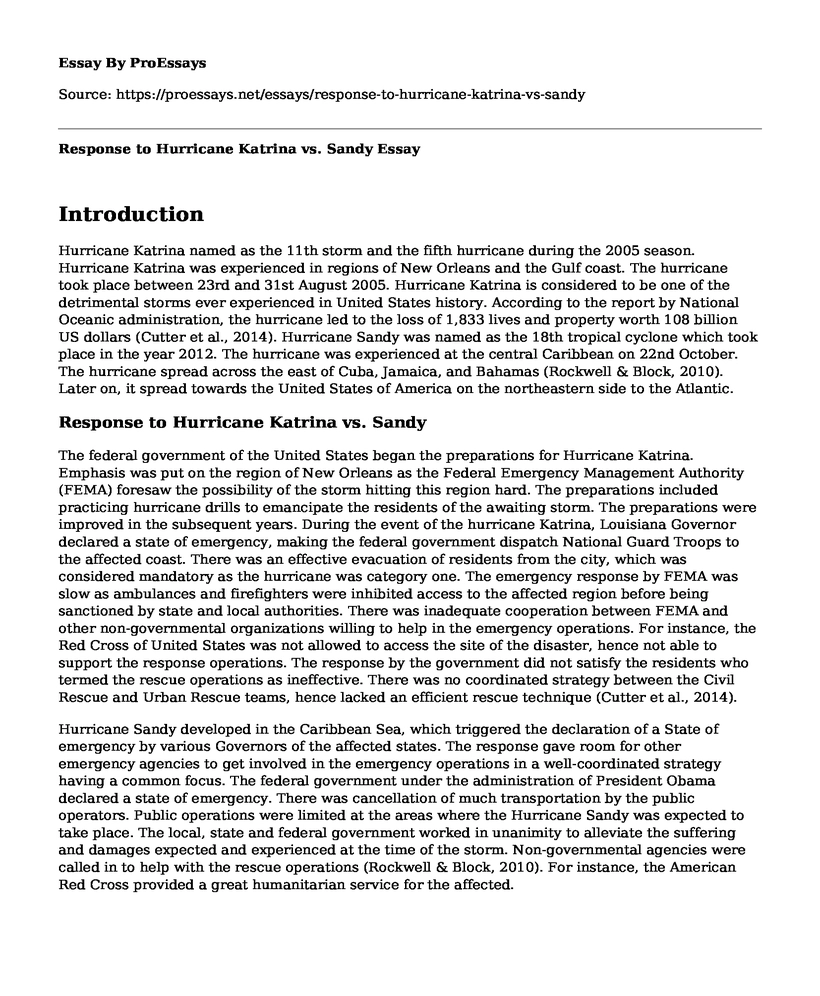Introduction
Hurricane Katrina named as the 11th storm and the fifth hurricane during the 2005 season. Hurricane Katrina was experienced in regions of New Orleans and the Gulf coast. The hurricane took place between 23rd and 31st August 2005. Hurricane Katrina is considered to be one of the detrimental storms ever experienced in United States history. According to the report by National Oceanic administration, the hurricane led to the loss of 1,833 lives and property worth 108 billion US dollars (Cutter et al., 2014). Hurricane Sandy was named as the 18th tropical cyclone which took place in the year 2012. The hurricane was experienced at the central Caribbean on 22nd October. The hurricane spread across the east of Cuba, Jamaica, and Bahamas (Rockwell & Block, 2010). Later on, it spread towards the United States of America on the northeastern side to the Atlantic.
Response to Hurricane Katrina vs. Sandy
The federal government of the United States began the preparations for Hurricane Katrina. Emphasis was put on the region of New Orleans as the Federal Emergency Management Authority (FEMA) foresaw the possibility of the storm hitting this region hard. The preparations included practicing hurricane drills to emancipate the residents of the awaiting storm. The preparations were improved in the subsequent years. During the event of the hurricane Katrina, Louisiana Governor declared a state of emergency, making the federal government dispatch National Guard Troops to the affected coast. There was an effective evacuation of residents from the city, which was considered mandatory as the hurricane was category one. The emergency response by FEMA was slow as ambulances and firefighters were inhibited access to the affected region before being sanctioned by state and local authorities. There was inadequate cooperation between FEMA and other non-governmental organizations willing to help in the emergency operations. For instance, the Red Cross of United States was not allowed to access the site of the disaster, hence not able to support the response operations. The response by the government did not satisfy the residents who termed the rescue operations as ineffective. There was no coordinated strategy between the Civil Rescue and Urban Rescue teams, hence lacked an efficient rescue technique (Cutter et al., 2014).
Hurricane Sandy developed in the Caribbean Sea, which triggered the declaration of a State of emergency by various Governors of the affected states. The response gave room for other emergency agencies to get involved in the emergency operations in a well-coordinated strategy having a common focus. The federal government under the administration of President Obama declared a state of emergency. There was cancellation of much transportation by the public operators. Public operations were limited at the areas where the Hurricane Sandy was expected to take place. The local, state and federal government worked in unanimity to alleviate the suffering and damages expected and experienced at the time of the storm. Non-governmental agencies were called in to help with the rescue operations (Rockwell & Block, 2010). For instance, the American Red Cross provided a great humanitarian service for the affected.
Similarities
Both rescue and response operations were marred with some level of racial bias and class. Not all regions were treated with the same degree of response. For instance, racial demographics in New Orleans is majorly composed of black people while New Jersey is mainly composed of white people. The federal government considered declaring a state of emergency during both instances of the hurricane, which enabled to facilitate the rescue mission. There was little response by the federal government to restore the affected areas post-hurricane, the arrears faced challenges which include lack of power, gasoline, and other necessities long after the hurricane.
References
Cutter, S., Emrich, C., Mitchell, J., Piegorsch, W., Smith, M., & Weber, L. (2014). Hurricane Katrina and the Forgotten Coast of Mississippi (p. Iii). Cambridge: Cambridge University Press.
Rockwell Jr., L., & Block, W. (2010). The Economics and Ethics of Hurricane Katrina. American Journal Of Economics And Sociology, 69(4), 1294-1320. doi: 10.1111/j.1536-7150.2010.00745.
Cite this page
Response to Hurricane Katrina vs. Sandy. (2022, Mar 25). Retrieved from https://proessays.net/essays/response-to-hurricane-katrina-vs-sandy
If you are the original author of this essay and no longer wish to have it published on the ProEssays website, please click below to request its removal:
- Carbon Tax Versus Cap-and-Trade - Paper Example
- Primary and Secondary Goals of the United States Energy Policy Essay
- Life During the Four Eras Processes of Fossilization Paper Example
- California's Water - Essay Sample
- Offshore Drilling in Louisiana Gulf: Potential Negative Impacts - Research Paper
- Biotechnology: Engineering Orgs. for Human Usage - Essay Sample
- Essay Example on Health Care Safety: Essential For Quality Service Delivery & Profitability







